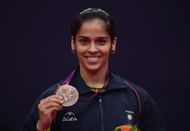
Saina Nehwal of India stands with her Bronze medal during London 2012 Olympic Games. Her name is often mispronounced as ‘Sania’ by media channels. (Getty Images)
Sharapova’s massive yearly earnings are not just because she is a very good player but also because she is a “good looking, tall, blonde” woman who happens to be good at her game. A lot of men tune in to watch her and not her game. The same people demean Serena Williams because she is not conventionally pretty despite the fact that she is twice the player that Sharapova can ever be.
There was a distinct buzz around the circuit when Sania Mirza arrived on the tennis scene. Unfortunately, the buzz was more because of how she looked than for how she played. Contrast that with Saina Nehwal‘s story. She is a player who has represented the nation with tenacity and a strong temperament on many occasions, but her name is often mispronounced as ‘Sania’ by media channels, because she is not ‘glamorous’ enough and is someone who minds her own business – attributes that people appreciate in sportsmen but alas, not in sportswomen.
It is okay when Rafael Nadal features in Shakira’s music video or when David Beckham poses half nude for fashion magazines, but it is not okay when Agnieszka Radwanska poses for a magazine’s body image issue (a topic which is relevant) because it makes her a bad role model. These double standards reek of ignorance and arrogance.
This article by Robert Jobson in the Daily Mail quotes a survey which mentions that one in every four people who come to watch a football match is a woman. That is 25% of your audience, and yet FIFA, football’s governing body, made changes to their rules to allow a woman to sit on the FIFA Executive Committee only as late as May 2012.
The BCCI – the governing body for cricket in India and the richest cricket board in the world – very conveniently seems to forget that it is responsible for not just the men’s game but also the women’s. Despite having all the resources at its disposal, very little has been done to make the women’s game popular in the country, forget about having women at the helm of affairs in some capacity. And this piece by Abhishek Purohit on ESPN Cricinfo further highlights the discriminatory attitude of BCCI towards women’s cricket.
So where does the buck stop? For starters, it would be great if more sportsmen came out in the open to talk about the importance of having female representation both on and off the field. That is what good role models should do. Sporting bodies around the globe should also ensure more diversity. This is in no way to suggest the inclusion of women at the cost of merit, but surely there is room for qualified and talented women across sporting lines in the world.
Hopefully, some day, women will be recognised and paid for their talent and not for their ability to look beautiful. And that day, James Browns’ song will become even more relevant.
